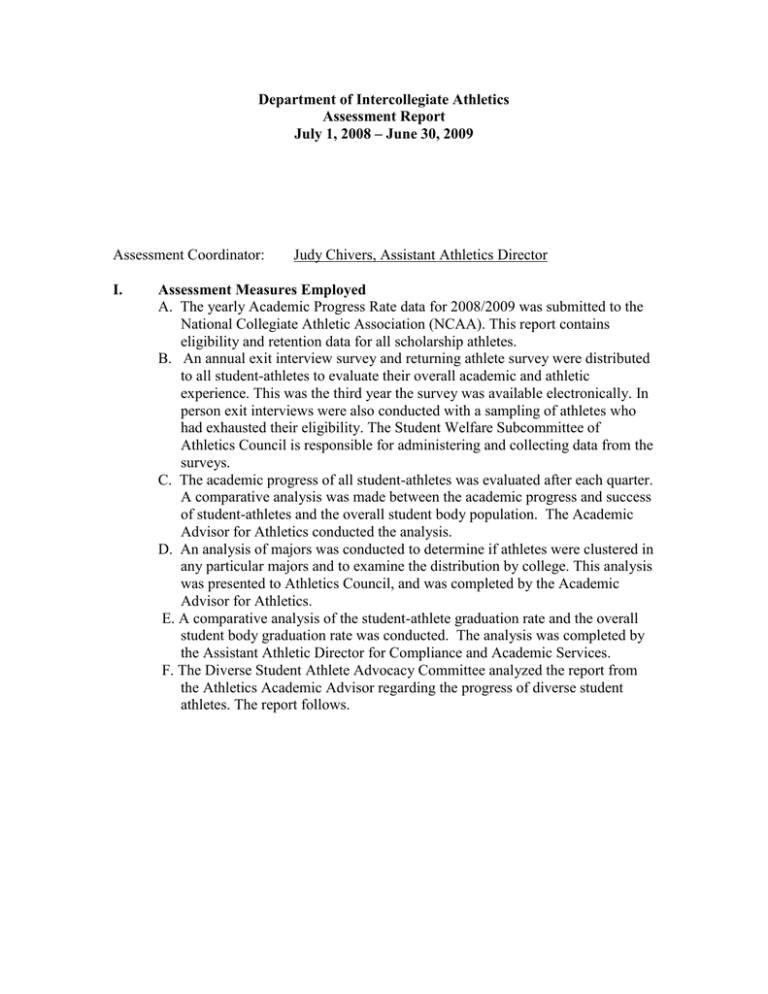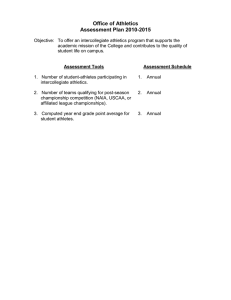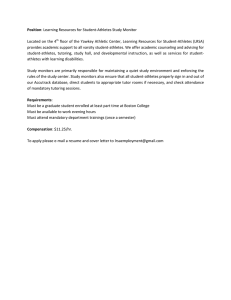Intercollegiate Athletics
advertisement

Department of Intercollegiate Athletics Assessment Report July 1, 2008 – June 30, 2009 Assessment Coordinator: I. Judy Chivers, Assistant Athletics Director Assessment Measures Employed A. The yearly Academic Progress Rate data for 2008/2009 was submitted to the National Collegiate Athletic Association (NCAA). This report contains eligibility and retention data for all scholarship athletes. B. An annual exit interview survey and returning athlete survey were distributed to all student-athletes to evaluate their overall academic and athletic experience. This was the third year the survey was available electronically. In person exit interviews were also conducted with a sampling of athletes who had exhausted their eligibility. The Student Welfare Subcommittee of Athletics Council is responsible for administering and collecting data from the surveys. C. The academic progress of all student-athletes was evaluated after each quarter. A comparative analysis was made between the academic progress and success of student-athletes and the overall student body population. The Academic Advisor for Athletics conducted the analysis. D. An analysis of majors was conducted to determine if athletes were clustered in any particular majors and to examine the distribution by college. This analysis was presented to Athletics Council, and was completed by the Academic Advisor for Athletics. E. A comparative analysis of the student-athlete graduation rate and the overall student body graduation rate was conducted. The analysis was completed by the Assistant Athletic Director for Compliance and Academic Services. F. The Diverse Student Athlete Advocacy Committee analyzed the report from the Athletics Academic Advisor regarding the progress of diverse student athletes. The report follows. II. Assessment Findings: A. The May 1, 2009 NCAA Division I release of Wright State’s Academic Progress Rate contains the following: NCAA Division I Academic Progress Rate released May, 2009 Wright State/ Multiyear Rate Men's Sports Baseball Basketball Cross Country Golf Soccer Softball Swimming Tennis Track Volleyball 962 946 972 960 951 N/A 972 940 978 N/A All Division I/ Multiyear Rate 946 933 964 963 958 N/A 967 964 954 N/A Wright All Division State/Multiyear I/ Multiyear Rate Rate Women's Sports N/A N/A 962 962 989 971 N/A N/A 966 973 929 968 994 979 990 974 963 965 964 972 B. Athletes with exhausted eligibility as well as returning student-athletes responded to surveys designed by the Student Wellness Subcommittee of Athletics Council to gather data on various aspects of both the academic and athletic experience at Wright State. The survey was administered through WebCT after each individual sport had concluded its competition segment for the year. On this survey, 61% of athletes reported their overall Wright State experience as either very good or excellent, and 39% reported the experience as average. For the athletes who were interviewed in person, all reported that they were satisfied with the overall experience, naming good team atmosphere, sense of belonging, and attention to academic achievement as some of the factors. Academic and social experiences were overwhelmingly positive, as were the helpfulness and availability of equipment room staff. Facility ratings depended in part on the sport of the athlete, with comments on the pool as being less than adequate, but weight training as excellent. Rating of academic support services was largely positive, but suggestions were made to improve study table productivity, response time to email inquiries, and academic updates. Overall experience Facilities and equipment Academic Services Equipment Room Support Athletic Training Availability n 36 36 mean 2.67 out of 4 (0.67) 3.41 out of 5 (0.682) standard deviation 0.585 1.250 36 36 4.14 out of 5 (0.83) 4.56 out of 5 (0.912) 0.798 0.558 36 4.33 out of 5 (0.866) 0.585 C. A comparative analysis between the quarterly and cumulative grade point averages of student-athletes and non student-athletes was conducted and reported to Athletics Council. The results of this analysis are located in the table below. Standard deviations and median grade point averages are reported to Athletics Council as well, along with a break-down of eligibility status for each team. Quarter and Cumulative Grade Point Average for 2008/2009 Fall Quarter 2008 Fall Cumulative Student-Athletes 2.886 3.005 All Students 2.810 2.931 Winter Quarter 2009 Winter Cumulative 2.977 3.007 2.823 2.926 Spring Quarter 2009 Spring Cumulative 2.959 3.011 2.820 2.940 During each academic quarter, the student-athletes performed better than non student-athletes. This affirms that the majority of student-athletes have successfully balanced the demands of being a full-time student and athlete while maintaining satisfactory progress towards their degree. D. An analysis of majors was completed by the Assistant Athletics Director shows that WSU athletes have majors across the university and are not overrepresented in particular educational programs—26 are in biological sciences, 21 are in psychology, 35 in organizational leadership, 10 in early childhood education, 19 in communication, 12 in nursing, 14 in marketing, 11 in accountancy, 9 in mechanical engineering and 8 in nursing. Other majors are represented to a lesser extent. E The NCAA Official 2009 Division I Graduation Rates Report contains the most recent data. The report examines the graduation rates of the freshmen cohort that entered Wright State University during the 2002-2003 academic year, as well as, the four-class graduation average. The data indicates that student-athletes are graduating at a higher percentage rate than the overall student body. Year 2003 2004 2005 2006 2007 2008 2009 Cohort 1996/1997 1997/1998 1998/1999 1999/2000 2000/2001 2001/2002 2002/2003 Fed Grad Rate / Fed Grad Rate/ Graduation Success Rate/ Athletes All Students Athletes 53% 37% did not exist 62% 40% did not exist 56% 41% 73% 68% 41% 75% 68% 43% 79% 69% 43% 80% 74% 43% 83% F. The Diverse Student Athlete Advocacy Committee requested and reviewed date pertaining to the numbers and achievement of diverse student athletes. The data and analysis from the 2008/2009 year-end report to Athletics Council contains the following. 1st Recommendation – Diverse student-athletes should strive for a graduation rate equal to or higher than the overall student-athlete graduation rate: The 2008 NCAA Graduation Rates Report data based on the 2001 Cohort of studentathletes at Wright State: 25 of 28 (89.29%) – non-minority student-athlete graduated 6 of 8 (75%) – diverse student-athletes graduated 2 of 2 (100%) – non-resident alien (international students) student-athletes graduated 2nd Recommendation: Diverse student-athletes should strive for a retention rate that is equal to or higher than the overall student-athlete retention rate (this variable looks at scholarship student athletes only). 2 Diverse student athletes not retained. 7 Non-Diverse student athletes not retained. 3rd Recommendation: The level of academic ineligibility for diverse student-athletes should be no higher than their proportional representation at Wright State University. Ineligible after Fall 2008: 7 Non-Diverse Student Athletes 2 Diverse Student Athletes Ineligible after Winter 2009 3 Non-Diverse Student Athletes 2 Diverse Student Athletes 4th Recommendation: Diverse student-athletes as a group should strive for a grade point average that is equal to or higher than the overall student-athlete grade point average: Overall student-athlete GPA after Winter 2009 Cumulative – 3.007 Term – 2.977 Student-Athletes GPA minus diverse student-athletes Cumulative – 3.057 Term – 3.031 Diverse Student-Athletes GPA Cumulative – 2.764 Term – 2.715 5th Recommendation: The Athletics Department will insure that the number of diverse participants in intercollegiate athletes will not fall below the percentage of diverse students at the university. The percentage of diverse student-athletes is 18.8% The percentage of undergraduate diverse students at Wright State is 18.04% III. Program Improvements The following list of program improvements, based on the assessment results, is being implemented during the 2009-10 academic year: 1. The Resource Center is being relocated in Fall 2009 to a more centralized location for the athletes, to facilitate usage and convenience. Computers have been upgraded as well as the printer, with use of NCAA Academic Enhancement funds. 2. Additional Resource Center monitors are being hired to monitor the very popular evening hours in the library to increase productive use of study time. 3. Life skills programming is being enhanced, as are the Student Athlete Advisory Council (SAAC) goals and objectives due to the creation of the new Special Assistant to the Athletics Director position in Athletics. Each seminar is followed by a survey of the attendees to determine effectiveness, clarity and helpfulness. IV. Assessment Plan Compliance Improvements in the senior exit interview process continue to be a priority for the Student Wellness Committee. Surveys are now distributed following the quarter a student-athlete’s eligibility expires. The Academic Progress Rate (APR) reported to the NCAA each fall, continues to garner much attention and monitoring. Quarterly updates of eligibility and retention points have been added to the Quarterly Grade report presented to Athletics Council to help anticipate upcoming concerns and to encourage early intervention. As the freshmen are generally the most at risk for immediate academic struggles, the Academic Advisor continues to facilitate the UVC 111 learning community class with visits from the Academic Success Center directors, University College advisors, Campus Police, Counseling and Wellness Services, and the Office of Community Standards. V. New Assessment Developments The department has hired a new Special Assistant to the Athletic Director/Life Skills Coordinator who is scheduling and implementing seminars and programs for student athletes on pertinent college success topics. Each seminar is followed by a survey of the attendees to determine effectiveness and clarity. The Special Assistant is also developing a new assessment tool to evaluate the effectiveness of the seminars.

